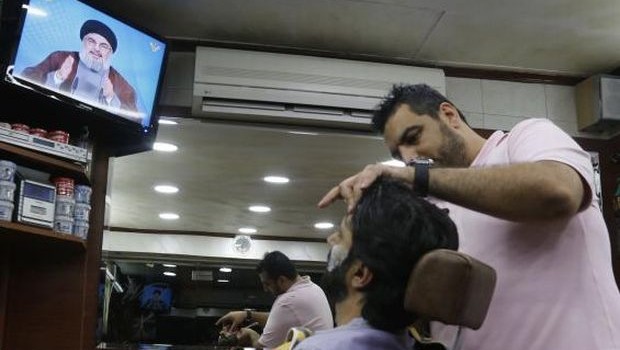
Lebanon’s Hezbollah leader Sayyed Hassan Nasrallah speaks on Al-Manar, Hezbollah’s official television channel, as a barber shaves a customer at a men’s hairdressing shop in Beirut on April 30, 2013. (REUTERS/Mohamed Azakir)
But now, with the overt role played by Hezbollah in the fighting in Syria, the division has become wider and more visible to anyone with access to the writing of Lebanese journalists.
Beirut’s Daily Star, the country’s leading English-language newspaper, published a news item on Tuesday on the Future Movement’s statement on Hezbollah’s “dangerous and criminal role” in Syria.
Also on Tuesday, the Arabic Al-Nahar, affiliated with the governing March 14 coalition, put out a piece entitled “Who will protect Tripoli from Syrian fire?” and another one on Wednesday entitled “The danger of chaos being transferred to Lebanon.”
On the same day, Al-Manar, Hezbollah’s official news agency, published an article on Tuesday on one of their websites quoting a statement by Hezbollah-affiliated MP Mohammad Raad claiming that “Hezbollah did not intervene in Syria; we rather intervened in Lebanon to defend Lebanon and its resistance and to protect the country.”
While Hezbollah’s Al-Manar avoids reporting about other Lebanese figures’ criticism of Lebanon’s involvement in the Syrian conflict, other news agencies repeatedly report condemnations of Hezbollah’s involvement and Nasrallah’s decisions.
In an article in Al-Nahar entitled “Everyone’s battle against everyone … in Lebanon,” Hezbollah’s intervention in Syria is described as the trigger that will “re-ignite fire within Lebanon.”
But the Hezbollah-affiliated media have consistently described its battle as being only against the Zionist regime represented in Syria by so-called takfirist terrorist gangs.
According to Al-Manar, Raad claimed: “We only point our rifle at any target we believe is allying itself with and conspiring with the Zionist enemy, because our rifle only fires on those who are allied with Israel or conspiring with it.” Most other news agency did not report Raad’s statement.
On the other hand, Al-Nahar published a statement by the Future Parliamentary blog suggesting that “Hezbollah was acting like one of Iran’s Revolutionary Guard divisions by fighting alongside regime forces throughout Syria.”
Al-Manar’s English-language website contains the logo of the Syrian Army, accompanied by a Syrian slogan: “Our brave Armed Forces were able at dawn to restore security and stability to Qusayr and cleanse it from the enormity of the terrorists.”
The divisions in the Lebanese media have also been exposed by the conspicuous absence of coverage of opposing points of view, and of statements from figures considered antithetical to the title’s backers. In one prominent example, Beirut’s Al-Balad newspaper published an article on the statement of the chief of staff of the Supreme Military Council of the Free Syrian Army, Salim Idriss, pledging to attack Hezbollah within Lebanon. Hezbollah’s online news website makes no mention of this claim.
